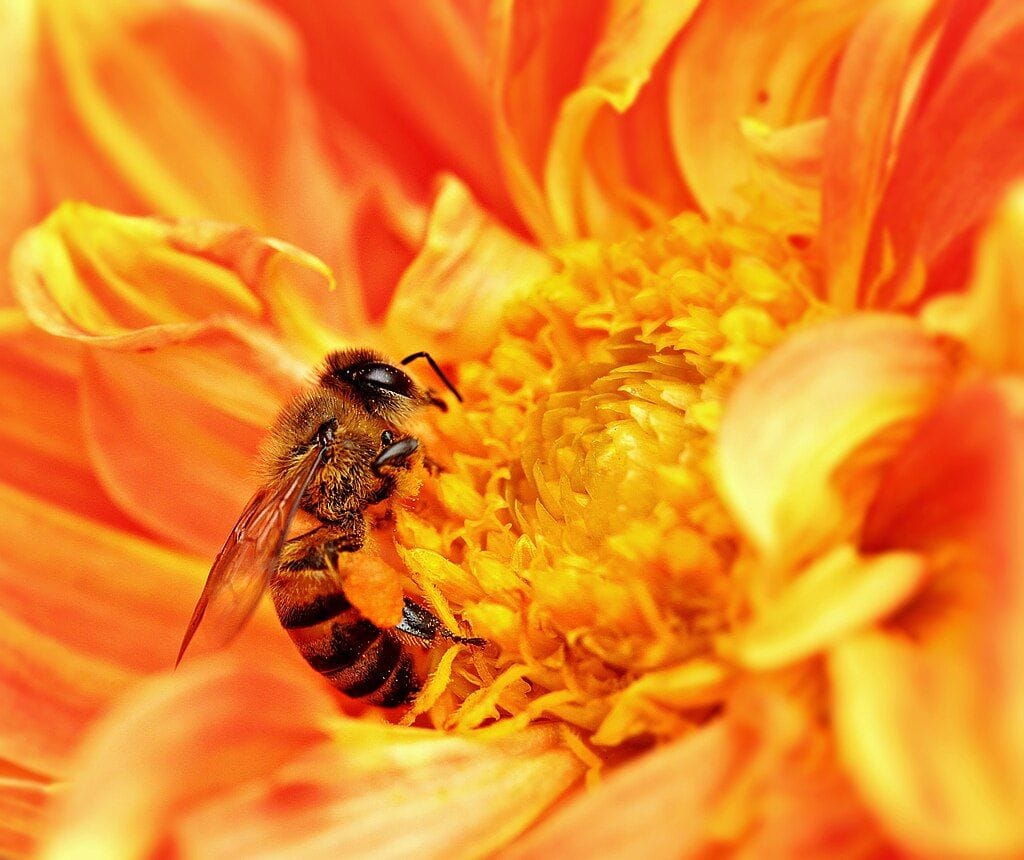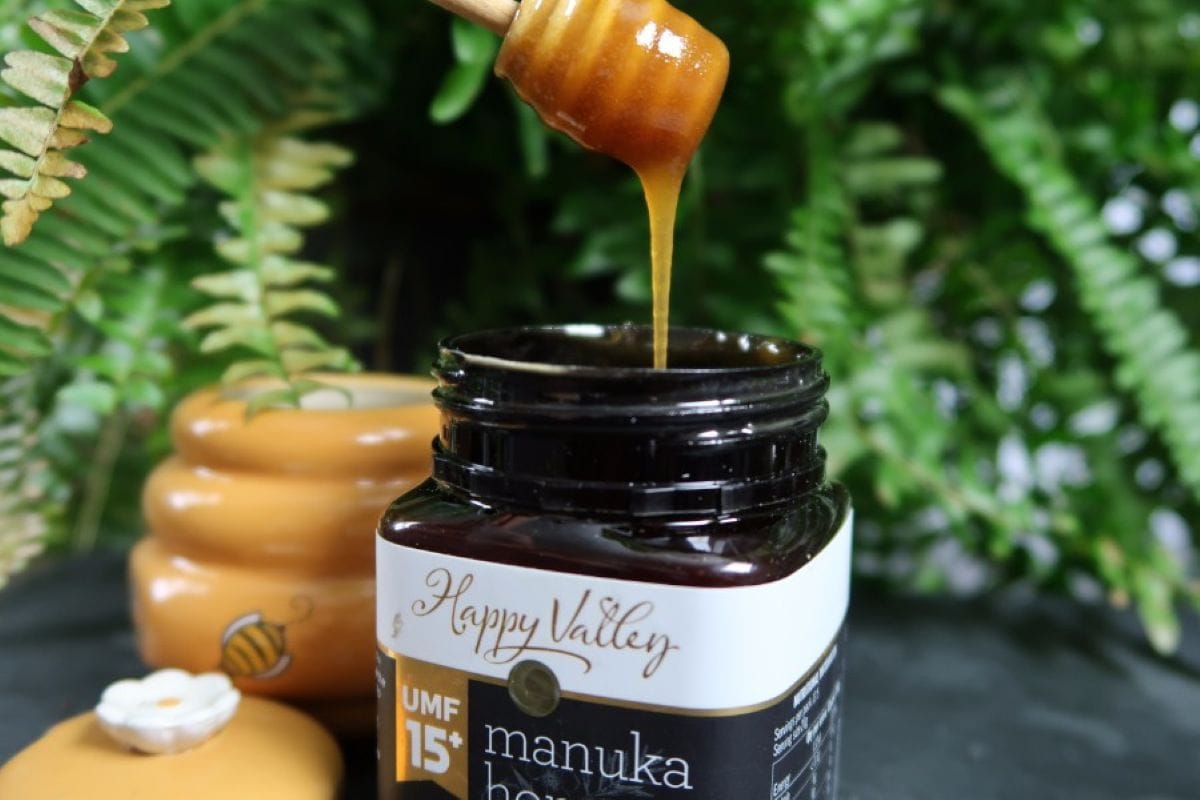
The Benefits of Honey have been valued for thousands of years—not only for its rich sweetness but also for its remarkable healing powers. From calming a sore throat to supporting faster wound recovery, honey is far more than a natural sweetener. Today, modern research confirms what ancient traditions knew all along. Studies from the World Health Organization (WHO) and the National Institutes of Health (NIH) highlight many proven health benefits of honey. However, not all honey is created equal. In this blog, we’ll uncover how bees make honey, the science-backed benefits, the most popular types from around the world, simple ways to tell real from fake, and more. Let’s explore nature’s golden treasure together.
Image Credit: Sajjad Fazel, CC BY-SA 3.0 <https://creativecommons.org/licenses/by-sa/3.0>, via Wikimedia Commons
How Do Bees Make Honey?
Bees produce honey from the nectar they gather from flowers. Here’s how the process works—step by step:
- Collecting Nectar: Worker bees fly from flower to flower, using their long tongues to suck up nectar.
- Storing in Honey Stomach: The nectar is stored in a special part of the bee’s body called the “honey stomach.”
- Passing It On: Back at the hive, the nectar is passed from bee to bee. This breaks down the sugars naturally.
- Drying the Nectar: The bees drop the nectar into honeycomb cells and fan it with their wings to remove moisture.
- Sealing It: Once thickened, the bees seal each cell with wax. That’s honey—ready to use!
Fun Fact: According to the National Honey Board (USA), it takes about 2 million flower visits to make just 1 pound of honey!
Proven Health Benefits of Honey
Honey isn’t just tasty—it’s good for your health too. Here are some science-backed benefits you should know:
1. Soothes Cough and Sore Throat
According to the World Health Organization (WHO), honey is a safe and effective remedy for coughs, especially in children over 1 year. It coats the throat and reduces irritation—without the side effects of some over-the-counter medicines.
2. Boosts Natural Energy
Honey contains natural sugars like glucose and fructose that provide a quick energy boost. It’s a great pre-workout snack or a natural sweetener in tea and smoothies.
3. Rich in Antioxidants
Raw honey contains antioxidants like flavonoids and phenolic acids, which help protect your body’s cells from damage. Studies on PubMed show that antioxidants in honey may lower the risk of heart disease.
4. Helps Heal Wounds and Burns
Manuka honey, in particular, has powerful antibacterial properties. Clinical studies supported by the National Institutes of Health (NIH) show that it can help heal minor burns, cuts, and skin infections.
5. Supports Digestive Health
Honey may act as a mild prebiotic, helping good bacteria in your gut grow. It’s also used traditionally to ease indigestion.
Important Note: While honey has many health benefits, it should still be used in moderation—especially for people with diabetes or children under 1 year of age (due to the risk of botulism).
Is Honey Really Good for You?
Yes, honey is good for you—but only when used the right way. It offers natural energy, antioxidants, and even healing properties, as shown in studies by the NIH and WHO. But there are a few things you should know:
What Makes Honey Healthy?
- Natural sugars give a quick energy boost without artificial additives.
- Raw honey keeps more nutrients because it isn’t heavily processed.
- Manuka honey has strong antibacterial effects, backed by medical studies.
When to Be Cautious
- Too much honey = too much sugar: It can raise blood sugar levels.
- Never give honey to babies under 1 year: The CDC warns this could cause infant botulism, a rare but serious illness.
- Check for purity: Some store-bought honey is mixed with sugar syrup or additives.
Expert Tip:
Choose raw, organic, or certified honey from trusted sources. Labels like USDA Organic, UMF (for Manuka), or AGMARK (India) can help you pick the right one.
Types of Honey You Should Know
Honey comes in many varieties, each with its own color, flavor, and health benefits. Its taste, color, and aroma depend on the flowers where bees gather nectar. Here are some well-known varieties from around the world:
1. Clover Honey (USA, Canada)
- Color: Light yellow
- Taste: Mild and sweet
- Common use: Tea, toast, and baking
2. Wildflower Honey (Worldwide)
- Color: Varies (usually dark)
- Taste: Rich and bold
- Health note: May help with seasonal allergies if locally sourced
3. Acacia Honey (Europe, Asia)
- Color: Very light, almost clear
- Taste: Mild and floral
- Special trait: Stays liquid longer, great for diabetics in small amounts (low glycemic index)
4. Manuka Honey (New Zealand)
- Color: Dark creamy
- Taste: Earthy, slightly bitter
- Medical use: Fights bacteria, helps heal wounds (recognized by NIH and hospitals)
5. Sidr Honey (Yemen, Middle East)
- Color: Golden-brown
- Taste: Thick, unique flavor
- Cultural value: Used in traditional medicine for centuries
Each type offers different health benefits, so try a few to find what suits your taste and wellness goals best!
Real vs. Fake Honey: How to Spot the Difference
Honey is one of the most adulterated natural products in the world today. According to the Food and Agriculture Organization (FAO) and global food fraud reports, cheap sugar syrups are often added to honey to increase quantity and reduce cost. Unfortunately, this makes it hard for consumers to trust what’s inside the jar.
Here’s how to check whether your honey is pure or fake:
1. Read the Label First (It Tells a Lot!)
Look for:
- 100% Pure, Raw, Unfiltered, or Organic Honey
- Avoid labels that say: “Honey Blend,” “Added Glucose,” “Corn Syrup”, or “Natural Flavoring”
- Trust these global certifications:
- USDA Organic – United States
- UMF / MGO – New Zealand (for Manuka honey)
- AGMARK – India
- Non-GMO Project Verified, EU Organic – International
2. Simple Home Tests for Purity
While not scientifically perfect, these at-home methods can help detect obvious fakes:
Water Test
- Fill a glass with water and add 1 spoon of honey.
- Pure honey settles at the bottom.
- Adulterated honey dissolves quickly or blends with water.
Thumb Test
- Put just a drop of honey on your thumb.
- Pure honey stays in place and doesn’t spread easily.
- Fake honey runs or spills quickly.
Burn Test (Use caution!)
- Dip a dry matchstick in honey, then strike it.
- If it lights, the honey is likely pure (no added moisture).
- If it doesn’t, it may contain water or sugar syrup.
Vinegar Test
- Mix a few drops of honey in water and add 2–3 drops of vinegar.
- If it foams, it may be adulterated with some chalk or similar powders.
3. Why Fake Honey is a Problem
- Lacks natural enzymes, antioxidants, and pollen
- Can raise blood sugar faster than real honey
- May contain harmful chemicals used in cheap syrups
- It’s hard to trace where it came from if pollen is removed
4. How to Buy Real Honey
- Buy from trusted brands or local beekeepers
- Look for lab-tested products (check brand websites for reports)
- If buying Manuka honey, check for UMF 10+ or higher with verified license number
Fact Check: A 2020 study published by Food Safety News reported that over 75% of honey samples from major U.S. grocery stores had been ultra-filtered, removing pollen and making it impossible to trace their source.
Smart Tip:
If your honey crystallizes (turns solid), that’s a good sign—real honey naturally crystallizes over time. Set the jar in warm water until it turns back into liquid.
Common Uses of Honey (Backed by Culture and Science)
Honey isn’t just a sweet treat—it’s a timeless remedy and ingredient with centuries of global trust.
Culinary Uses
Honey is widely used as a natural sweetener in beverages, desserts, marinades, and salad dressings. Unlike refined sugar, honey contains trace minerals and antioxidants. A study in the Journal of Agricultural and Food Chemistry found that darker honeys typically have higher antioxidant content.
Home Remedies
Many cultures use honey for sore throat, cough, and minor burns. Scientific studies support these practices.
- The World Health Organization (WHO) recognizes honey as a demulcent, soothing the throat.
- A 2012 study published in Pediatrics showed honey to be more effective than dextromethorphan for nighttime cough in children (over age 1).
Skincare and Wound Healing
Honey’s healing properties are recognized by modern science:
- According to the U.S. National Institutes of Health (NIH) and Mayo Clinic, medical-grade honey (especially Manuka honey) supports wound healing by reducing inflammation and bacterial growth.
- It’s also used in DIY face masks to hydrate and treat acne due to its antibacterial properties.
Cultural Roots
- Ayurveda: Honey is known as Madhu and is used to balance Kapha dosha.
- Unani medicine: Honey is considered “hot and dry” and used to expel phlegm and aid digestion.
- Western Herbalism: It’s often combined with herbs like ginger or garlic for better absorption and added therapeutic value.
Scientific reviews, such as one published in the journal Antioxidants, have highlighted honey’s strong antioxidant capacity, which helps protect against oxidative stress, support cardiovascular health, and enhance healing processes.
Conclusion: Why Honey Deserves a Spot in Every Home
Honey is more than a sweetener—it’s a gift from nature that connects ancient wisdom with modern science. Trusted for thousands of years, today’s research confirms what traditional medicine already knew:
- It has antibacterial and anti-inflammatory benefits.
- It’s useful in cooking, healing, skincare, and immunity.
- It can be stored indefinitely when handled correctly.
Choosing real, raw, and certified honey ensures you enjoy both its taste and health benefits. Make it a staple in your home—naturally.
Many people experience shortness of breath or fatigue during humid weather. Simple daily breathing techniques can help improve lung function and provide relief. You can check out our 7 Easy Breathing Exercises for Relief in Humid Weather for step-by-step guidance.
Call to Action
Ready to experience the power of real honey?
Start by adding a spoonful to your tea, face mask, or first-aid kit.
Buy authentic, certified honey from trusted sources—check for FSSAI (India), USDA Organic (USA), or UMF (for Manuka).
Share your story: Do you have a traditional home remedy with honey? Drop it in the comments or tag us in your experience!
Frequently Asked Questions (FAQs)
Q1: Does honey expire?
No. According to the Smithsonian Institution, archaeologists found pots of honey in ancient Egyptian tombs that were over 3,000 years old and still edible. The U.S. FDA confirms honey has an indefinite shelf life if stored properly.
Q2: Can babies eat honey?
No. The Centers for Disease Control and Prevention (CDC) and World Health Organization (WHO) strongly advise against giving honey to infants under 1 year due to the risk of infant botulism caused by Clostridium botulinum spores.
Q3: How long does honey last once opened?
When stored in a sealed container at room temperature, honey can last for years without going bad. Over time, it might form crystals, but it’s still perfectly safe to consume. Placing it in warm water will bring it back to a smooth, liquid state.
Q4: What are 10 quick facts about honey?
Bees need to visit 2 million flowers to make 1 pound of honey.
It never spoils.
Raw honey contains enzymes, pollen, and antioxidants.
It’s used in over 40 traditional medicine systems.
Can act as a natural cough suppressant.
Medical-grade honey is used in wound dressings.
Honey is 80% sugar, 18% water.
It can help preserve fruits and nuts.
Ancient cultures used it in religious rituals.
It’s a natural source of hydrogen peroxide (mild antiseptic).
Q5: Is raw honey better than processed honey?
Yes, in most cases. Raw honey retains enzymes like diastase and glucose oxidase, as well as antioxidants and pollen. A study published in the Journal of Food Science confirmed that pasteurization reduces many of these beneficial elements.


Leave a Reply